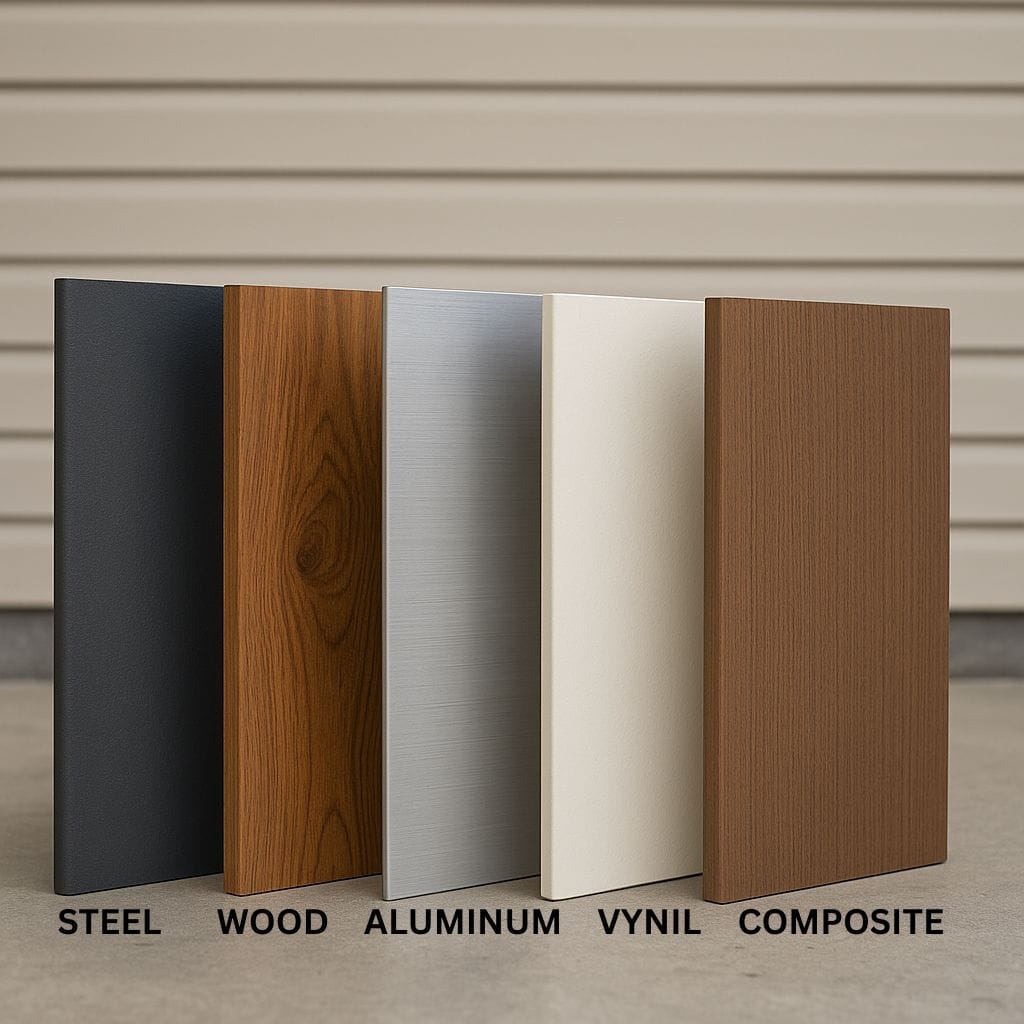Every homeowner wants to make smart investments that add value to their home without draining their wallet. Recently, we worked with a family in the Crestview neighborhood of Austin who believed installing a new garage door would be too expensive. By guiding them through the process, helping them choose a cost-effective yet high-quality garage door, and timing the installation perfectly, we helped them save over $600, all while improving the curb appeal and energy efficiency of their home.
According to Remodeling Magazine’s 2024 report, a new garage door installation ranks among the top home improvement projects in terms of return on investment, boasting an average 102.7% ROI in the Austin area. That means installing a new garage door isn’t just a cost, it’s a smart financial move that pays off both in function and resale value.
At Ramsey Garage Doors Co., we specialize in helping homeowners across Austin make affordable and informed choices for their residential garage door installation needs. This comprehensive guide will walk you through the steps, tips, and features you should know to save money while ensuring safe, smooth operation and long-term performance.
Understand Your Garage Door Needs
Before you dive into the installation process, it’s essential to evaluate what type of garage door system you need. Many Austin homes have varying structural layouts, from detached garages with wide garage openings to tight spaces that require vertical lift designs. The size, usage, and insulation requirements of your garage will influence which garage door is best for your home.
Consider the following:
- Usage Frequency: Will this garage door be used multiple times daily, or just occasionally? Frequent use demands a more durable garage door opener, higher-cycle torsion springs, and stronger brackets and hinges for safe operation.
- Energy Efficiency Needs: For attached garages, choose insulated garage door panels with a higher R-value to reduce energy consumption. Doors with layered steel and polyurethane insulation help maintain indoor temperature and reduce utility bills.
- Aesthetic Style: Garage door sections and panels come in various styles—carriage house, contemporary, or traditional raised-panel—so match your door to your home’s architecture for improved curb appeal.
Choose the Right Material
Garage doors come in several materials, each affecting cost, maintenance, insulation value, and overall durability. Understanding your options will help you make a budget-friendly choice without sacrificing functionality.
- Steel: The most common and affordable material. Modern steel garage doors are available in multiple thicknesses (gauges), with or without insulation. Ideal for Austin’s climate, especially when coated with a weather-resistant finish.
- Wood: Elegant and timeless, but requires more routine maintenance. Although visually appealing, wood garage doors need weather sealing, especially in humid or rainy seasons.
- Aluminum: Lightweight and rust-resistant, perfect for modern-style homes. However, they dent easily and are less energy-efficient unless insulated.
- Vinyl: Durable and low-maintenance, vinyl resists dents and cracking. It’s a cost-effective option for families seeking longevity with minimal upkeep.
- Composite: A hybrid material that mimics the look of wood without the high cost or maintenance needs. Durable and often comes with factory-installed insulation.

When helping a client in the Zilker area, we recommended a steel garage door with injected foam insulation, which balanced their needs for appearance, efficiency, and cost.
Time Your Installation for Maximum Savings
Did you know that the timing of your garage door installation can significantly affect the price? Spring and summer are peak seasons, often leading to longer wait times and higher labor costs. On the other hand, fall and winter months see reduced demand, which can translate into discounts and faster scheduling.
At Ramsey Garage Doors Co., we recommend scheduling your residential garage door installation during Austin’s cooler months, such as November or February. Not only will you get better rates, but materials like steel and insulation also install better in lower humidity conditions.
Avoid Unnecessary Add-Ons and Upgrades
It’s easy to get carried away with high-end add-ons during the installation process, but many of these features aren’t essential, at least not right away.
Be mindful of these cost-inflating extras:
- Decorative garage door panels, windows, and handles
- High-end garage door openers with Wi-Fi, voice control, and app integration
- Built-in lighting and custom paint finishes
- Insulated top sections when the garage opening doesn’t face direct sunlight
When working with clients in South Austin, we often suggest starting with a standard steel garage door and upgrading with add-ons like window panels or smart garage door openers later. You can install those features without replacing the whole system.
Compare Quotes, But Look at the Fine Print
Getting multiple quotes is essential, but remember: the lowest price isn’t always the best value. Pay attention to what’s included in each estimate to avoid hidden fees later.
Here are the components to check in every quote:
- Removal and disposal of your old door
- Installation of garage door opener and safety sensors
- Replacement of torsion springs, center brackets, flag brackets, horizontal tracks, vertical tracks, and other worn components
- Lubrication, testing, and adjustment for smooth operation
Warranty details (parts and labor)
A seemingly cheap quote that excludes necessary tools, spring tension balancing, or cables can end up costing you more in the long run.
Use Rebates and Incentives to Offset Costs
Austin homeowners can benefit from local rebates and utility programs when installing energy-efficient garage doors. High-R-value garage door panels with insulation may qualify for rebates from:
- Austin Energy: Periodically offers home energy efficiency upgrades
- Texas Gas Service: Offers incentives for home improvements that lower heating costs
Before beginning the installation process, consult with your installer or utility provider to see if your garage door system meets the rebate criteria.
Prioritize Maintenance and Warranty Coverage
Saving money isn’t just about upfront cost—it’s also about avoiding future repairs. Routine garage door maintenance is essential for extending the life of your garage door opener, springs, cables, and panels.
Here’s what regular maintenance should include:
- Tightening bolts, brackets, and hinges
- Lubricating the torsion tube, track, and springs
- Checking safety sensors and auto-reverse systems
- Inspecting cables for fraying and drums for alignment
- Examining the bottom panel weather stripping for wear
Also, make sure your new garage door comes with both a manufacturer’s warranty and a labor warranty from your installer. At Ramsey Garage Doors Co., we provide multi-year warranties on parts and labor to ensure peace of mind.
Avoid DIY Unless You’re Trained
DIY installation might seem like a way to save money, but garage doors are heavy, complex systems that require technical skill, specialized tools, and strict safety procedures.
A successful garage door installation requires:
- Measuring the garage door opening
- Assembling and installing the bottom panel, followed by additional garage door sections
- Securing vertical tracks, horizontal tracks, and the torsion spring system
- Mounting the garage door opener to the ceiling
- Adjusting spring tension and testing for proper operation
Missing just one step in this step-by-step guide can cause spring injuries, faulty bracket installations, or damage to your garage door panels.
Leave the installation to a professional garage door technician who knows how to safely handle torsion springs, align the vertical track, and balance the spring tension using tools like zinc hex lag bolts, vise grips, and cones.
Look for Package Deals and Local Discounts
Many garage door companies offer deals when you bundle multiple services. For example, if you’re replacing your old door and installing a new garage door opener, ask if there’s a discounted combo rate.
You might also find deals for:
- Seniors, veterans, and first responders
- HOA group installations
- Referrals and repeat business
At Ramsey Garage Doors Co., we regularly offer package pricing on garage doors and openers for homeowners in areas like Hyde Park and Allandale. Ask us how you can qualify for a bundled deal that fits your budget.
How Can Ramsey Garage Doors Co. Help You?
At Ramsey Garage Doors Co., we’re proud to be a trusted name in residential garage door installation across Austin, TX. Our team of highly trained technicians is equipped with the knowledge, tools, and experience to deliver a successful installation that’s both affordable and reliable.
Whether you’re replacing an old door, upgrading your garage door opener, or starting fresh with a new garage door, we’ll walk you through every step of the installation process—from selecting the right garage door panels and brackets to safely mounting the torsion tube and ensuring smooth operation.
📍 Visit us: 5502 Burnet Rd, Austin, TX 78756
📞 Call us: (512) 675-6884
We’re here to help you improve your home’s curb appeal, energy efficiency, and garage door performance—all while saving money. Contact us today for a free consultation, and let’s build a better garage together!
FAQs About Residential Garage Door Installation in Austin
1. How long does a typical residential garage door installation take?
Most standard garage door installations take 4 to 6 hours, depending on the size of the door and whether the opener is also being installed.
2. Do I need a permit to install a new garage door in Austin, TX?
Yes, the City of Austin generally requires a building permit for garage door replacements or installations, especially if structural modifications are involved.
3. What size garage door do I need for a two-car garage?
A typical two-car garage door is 16 feet wide by 7 feet high, though custom sizes can be ordered to fit non-standard openings.
4. Can I reuse my old garage door opener with a new door?
In some cases, yes—but it depends on the compatibility, power, and condition of your existing opener compared to the weight and style of the new door.

